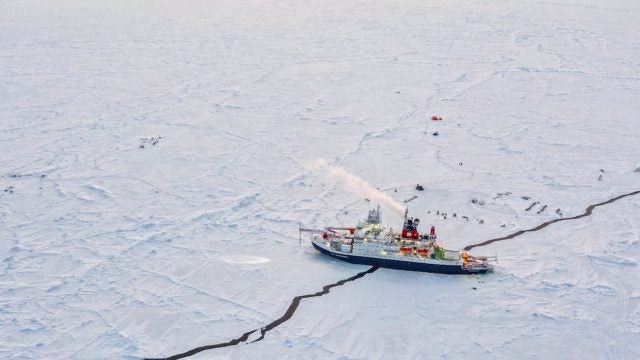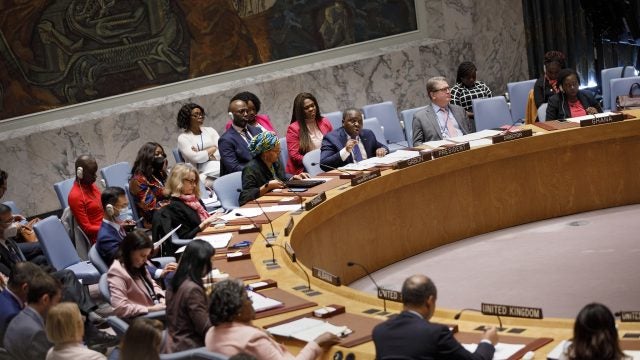
Title: Peacekeepers and Political Stability in Somalia
Since December 2017, about 8,000 peacekeepers have been withdrawn from the African Union’s 22,000-strong force in Somalia amid an increasingly costly stalemate with al-Shabaab that has depleted troop morale. The AU is still trying to implement an effective exit strategy for its Transition Mission (ATMIS), but it will inevitably face a series of challenges including the ongoing war against al-Shabaab militants, the speed of the transition, the mission’s force posture, and logistical and financial obstacles. Mitigating these challenges will be necessary to ensure that the mission’s departure occurs relatively smoothly and does not worsen political instability in Somalia.
Somalia’s War on al-Shabaab
Somalia is in the midst of an ongoing war against al-Shabaab, a militant group whose stated objective is to eject all foreign forces and replace the Federal Government of Somalia (FGS) with an Islamist caliphate. One of the deadliest in Africa, the war involves approximately 40,000 Somali army, AU, and Ethiopian soldiers fighting an estimated 7,000-12,000 al-Shabaab militants. AU forces have been fighting al-Shabaab since 2007 when they were deployed to protect the fledgling Somali authorities in Mogadishu. Despite al-Shabaab’s numerical disadvantage, the war has been stuck in a strategic stalemate since 2016. The FGS and its partners hold most major urban settlements, but al-Shabaab holds sway in large parts of the countryside. And while the FGS has not stopped al-Shabaab’s ability to conduct military operations, al-Shabaab’s guerrilla tactics have failed to dislodge Somalia’s federal or regional authorities.
Starting in August 2022, however, the FGS worked with local clan forces, the United States, Turkey, and ATMIS to wage an offensive campaign against al-Shabaab in the Hirshabelle and Galmudug regions of central Somalia, dislodging al-Shabaab fighters from over 215 locations. Unfortunately, this progress was hampered by the FGS’s longstanding inability to implement its stabilization strategy, which was intended to bring humanitarian relief, reconstruction projects, as well as governance and justice mechanisms to people in the recovered settlements. Al-Shabaab consequently regrouped in 2023 and counterattacked, inflicting hundreds of casualties among Somali and AU forces, stealing military equipment, and regaining a number of settlements. Today, it remains a resilient and adaptable foe. The group has recruited more personnel and continues to generate sufficient revenue to sustain its war of destabilization and harassment against Somali and AU forces. Furthermore, the militants have infiltrated Somalia’s army, police, and intelligence services, and maintain a sizable body of sympathizers within the political class, including parliamentarians.
A Costly Stalemate for ATMIS
It is widely recognized that despite the recent offensive, AU and Somali forces will not defeat al-Shabaab by brute force—certainly not in the foreseeable future. ATMIS forces were thinly spread over a vast area manning approximately 70 operating bases. As a result, the stalemate became much more expensive for the AU and its partners than for al-Shabaab, which can maintain its guerrilla operations much more cheaply.
For instance, AU and Somali forces remain unable to secure the main supply routes between their bases from IEDs and ambushes. This has meant that delivery of much logistical and combat support (provided by the UN Support Office for Somalia, UNSOS) requires aviation assets, which are much more expensive than land convoys. The ATMIS force posture also reduces the mission’s ability to control captured areas or sustain offensive operations fully. This has allowed al-Shabaab considerable freedom of movement, which it has used to carry out deadly attacks on AU bases and operate dozens of lucrative tax checkpoints for traveling populations.
The dispersed force posture is a major reason why ATMIS has played only a backseat role in the Somali-led offensive, providing some artillery support, casualty evacuation, and subsequent treatment of Somali wounded in its medical facilities. As a result, the FGS has realized that it cannot depend on ATMIS and indicated it would rather build a military of 30,000 troops from Ethiopia, Kenya, and Djibouti operating on a bilateral basis.
Money has also been negatively affecting ATMIS morale. After initially receiving stipends of only $500 per month, in 2009, the European Union (EU) and AU agreed to compensate AU peacekeepers at the base rate for UN peacekeepers, which at the time was $1,028 per month. In January 2016, however, the European Commission reduced its stipend payments to AU peacekeepers by 20%, to about $800 per month. Since then, the AU has not found another partner to cover the gap, although the UK contributed £25 million for troop stipends in 2022. Financing therefore remains a sore point for ATMIS. It is also a problem for the Somali security sector, with the FGS struggling to afford its own sustainable set of forces.
The Current Context
Despite not defeating al-Shabaab and the many problems facing the Somali National Army, the ATMIS peacekeepers are scheduled to be fully withdrawn by 31 December 2024. Ideally, the ATMIS drawdown would occur only after a negotiated peace settlement with al-Shabaab. Instead, AU forces are leaving Somalia without a peace process—let alone a peace agreement—in sight. This is because the FGS is no longer keen to host them, and the AU’s international partners are no longer keen to pay for them.
The best-case scenario is that the peacekeepers’ exit might pressure the FGS to finally get its own house in order and implement the constitutional and security reforms necessary to stabilize Somalia. The worst-case scenario is that the ATMIS departure will embolden al-Shabaab and the Somali Army will disintegrate under the subsequent pressure.
A Tricky Transition Timeline
As ATMIS tries to implement its exit strategy, it faces multiple challenges in this turbulent context. The early stages of the ATMIS exit have been far from smooth. Peace operations can, and should, voluntarily exit their theater via a planned timetable or conditions-based benchmark criteria. According to UN Security Council Resolution 2628 (2022), the planned ATMIS timetable has four phases, set to conclude by 31 December 2024. However, as Uganda’s current contingent commander in Somalia put it, “…this timeline is not static or cast in stone.”
Phase 1 was delayed because the Somali government called for a review of the operational timeline, generating a “technical pause” which saw 2,000 AU troops depart Somalia in June 2023, instead of in December 2022 as originally planned. During Phase 2 instead of 3,000 peacekeepers leaving as planned by 31 June 2023, the FGS, AU, and UN Security Council agreed to a second “technical pause” of their departure for three months. The stated reasons given by the FGS were al-Shabaab’s deadly attack on Somali forces at Cosweyn, the remote locations of the forward operating bases being transferred in Phase 2 amid logistical shortfalls. Additional confusion arose in mid-September 2023 when the FGS announced that it wanted to expel the entire 850-strong ATMIS police contingent as part of the 3,000 reduction. This was not envisaged in Resolution 2628, which stated ATMIS would retain a “minimum of 1,040 police personnel.” While in Phase 3, another 4,000 ATMIS troops are scheduled to leave Somalia by 30 June 2024, the current conditions seem to be headed for another delay.
Logistical Nightmares
Logistics have always been a major challenge for AU peacekeepers in Somalia. AU peacekeepers struggled so much that in 2009, the UN created an unprecedented mechanism called the UN Support Office to AMISOM to provide them with logistical support. Renamed UNSOS in 2015, it has established Joint Operations Centers and Joint Operational Logistics Bases across the mission’s sectors to coordinate the transfer of operating bases from ATMIS to Somali forces and oversee their closure and removal of equipment if necessary.
One problem, however, is that some ATMIS forward operating bases tend to be further from local population centers than the Somali army’s preferred locations. Relocating such bases costs significant time and money but maintaining them in locations vulnerable to al-Shabaab attacks is not ideal either. Recent heavy rains have also flooded some operating bases, affecting the supplies reaching troops and their ability to support the local population.
At the strategic level, UNSOS remains stuck facing two contradictory imperatives: to support the ATMIS drawdown while simultaneously supporting an ongoing offensive campaign, which might be extended to a new southern front. It remains uncertain how the Somalis would ensure the necessary logistical support for their forces without ATMIS and UNSOS.
Moving Forward: A More Mobile Mission
So far, the debate about the ATMIS transition has revolved around the largely tactical-level issue of which operating bases to transfer to the Somali army and which to close. However, this is not the central strategic issue facing the mission. A better debate would discuss how to garrison most ATMIS forces in a few key urban areas without the need for dozens of forward operating bases. The AU troops could then partner with Somali forces to conduct sustained, mobile offensive campaigns against al-Shabaab. This approach would mean that when ATMIS does withdraw, the Somali army would not be tethered to a similarly rigid, dispersed force posture, which has not seriously degraded al-Shabaab and instead produced a costly, often deadly, strategic stalemate.
…
Paul D. Williams is Professor of International Affairs at George Washington University where he directs the Security Policy Studies MA Program. His books include Fighting for Peace in Somalia: A History and Analysis of the African Union Mission (AMISOM), 2007-2017 (Oxford University Press, 2018).
Image Credit: Wikimedia Commons
Recommended Articles

This article explores the uncertain future of Arctic governance amid shifting global geopolitics. It argues that whether Washington and Moscow opt for confrontation or cooperation, multilateralism in the Arctic…

Twenty-five years ago, the United Nations Security Council adopted Resolution 1325, establishing a framework that underpins the Women, Peace, and Security (WPS) Agenda. The Resolution recognized both the…

When we analyze conflicts in the Middle East, we are not analyzing conflicts with isolated impacts but risks for global energy security. Recent conflicts in the Middle East have highlighted…